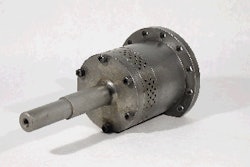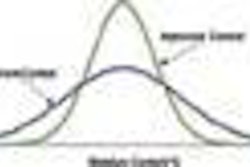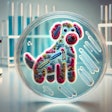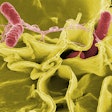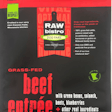As costs for protein sources increase, byproducts have become a more important primary protein source for a variety of animals. Optimizing economic utilization of byproducts for nutritional requirements is difficult to achieve given the varied protein quality of the source. This variance is due to several reasons: The variety of very different protein components, including highly-unavailable structural proteins that make up byproduct; variances in proportions of these respective protein components; and the effect of varying rendering conditions on protein physicochemical structure.
Therefore, assessing availability of a protein source is essential for proper dietary formulation in petfoods. However, to incorporate sources in the most cost-effective manner, accurate and timely prediction of amino acid quality prior to use is desired. Likewise, the producer of the rendered byproduct needs analytical methods which can be used to confirm that a product has a specified nutritional value (Johnston and Coon, 1979).
Bioassays for nutritional quality
Although chemical and HPLC-based methods can provide quantitative estimates of total amino acids in a petfood or protein source, these estimates do not necessarily reflect biological availability. Animal bioassays involving either rats or chicks are the standard accepted practice for evaluating bioavailable protein quality, but such assays have several limitations.
Alternative in vitro tests that accurately predict amino acid availability would solve many of the problems associated with currently-used animal bioassays. Availability of such assays would allow more flexibility time wise for protein feedstock purchases, decreased cost for assays on individual protein sources and perhaps a wider range of protein sources for use in petfood formulations.
Since dietary source quality is dependent on both amino acid composition and digestibility, animal bioassays have generally been used to establish quality parameters. Although animal bioassay procedures can provide an accurate assessment of the availability of a particular protein source, they require anywhere from 2-4 weeks to complete for growing animal studies (Johnston and Coon, 1979) and at least 2 days (Parsons, 1985) for cecectomized rooster assays disallowing practical usefulness for on-site and subsequent rapid turn-around quality measurement of a protein source.
Given the labor intensive nature, time-consuming methods and the considerable variation derived from animal procedures, microbiological assays for protein quality assessment offer a rapid, relatively-inexpensive alternative which is amendable for testing large numbers of samples efficiently (Haenel and Kharatyan, 1973).
Microbial-based bioassays
Microbiological methods have been used for biological assays of amino acids from a variety of biological materials and have been used to determine amino acid availability in acid hydrolysate protein quality determinations (Haenel and Kharatyan, 1973). Several amino acids have been assayed using a variety of wild type or "natural" auxotrophs (require specific growth factors) of amino acid-requiring organisms including lactic acid bacteria ( Leuconostoc , Lactobacillus , and Streptococcus spp .) and the ciliate protozoa Tetrahehymena pyriformis (Boyne, et al ., 1975; Payne, et al ., 1977) as well as Escherichia coli auxotrophic generated mutants (Payne, et al ., 1977; Anantharaman, et al ., 1983; Tuffnell and Payne, 1985).
Most of these organisms are not highly proteolytic and, to achieve protein availability, the protein source in question is subjected to protease treatment prior to quantitation of the amino acid (Payne and Tuffnell, 1980; Tuffnell and Payne, 1985). Choice of a bioassay organism is dependent on a number of factors outlined by Payne and Tuffnell (1980) and includes:
- Specific microbial response to the substrate without interference by other sample components;
- Ease of cultivation;
- Non-pathogenic;
- Stable nutritional requirements;
- Sensitive and quantitatively measurable response; and
- High degree of correlation with relevant biological assays.
Although organisms such as the lactic acid bacteria meet most of these criteria, they suffer the limitation of having complex, and therefore unpredictable, growth requirements leading to variable growth responses (Payne and Tuffnell, 1980; Tuffnell and Payne, 1985). Of the organisms examined, Escherichia coli appears likely to be consistently reliable. In addition, the ability to use colorimetric assays for quantitating E. coli growth response can increase the sensitivity nearly 100-fold, (decreasing the assay time to approximately 2 hours), and subsequently avoid microbial contamination problems experienced with microbiological assays that require longer incubation times (Tuffnell and Payne, 1985).
Escherichia coli as a bioassay organism
Rapid microbiological methods involving E. coli have been tested for a number of amino acids, but have been primarily focused on lysine and methionine (Payne, et al ., 1977; Anantharaman, et al ., 1983; Tuffnell and Payne, 1985; Hitchins, et al ., 1989; Erickson, et al ., 1999, 2000, 2002; Froelich, et al ., 2002a,b,c; Zabala DÃaz, et al ., 2003, 2004). Two criteria must be met before practical routine application of E. coli for estimating overall protein quality can be implemented.
First of all, E. coli growth characteristics on petfood proteins must be fully characterized to eliminate or at least be able to predict any response problems that may be unique to individual protein sources. Secondly, a rigorous comparison of E. coli -based estimations of protein quality must be made with the standard animal bioassays on typical petfood protein sources.
E. coli mutant auxotrophs offer several positive attributes as ideal bioassay organisms (Tuffnell and Payne, 1985). Not only are the genetics of E. coli well understood, but molecular techniques are highly routine for this organism. Consequently, E. coli is quite genetic engineering-friendly for the creation of very specific mutants and designing bioassays for most nutrients of interest. Furthermore, E. coli is a part of the intestinal microflora found in most animals and humans and would be expected to have an amino acid utilization capability similar to the small intestinal epithelial cells it would compete with for incoming feed proteins.
Although E. coli lysine auxotrophs have previously been tested for specific amino acids such as lysine (Tuffnell and Payne, 1985; Hitchins, et al ., 1989), our laboratory has made several recent improvements and modifications of E. coli amino acid assays to increase the accuracy (optimized protease pre-digestion step) and refine the reproducibility (selective media to support growth of only the specific amino acid auxotroph), such that in our hands E. coli -determined amino acid availability yields (lysine) are highly correlated to animal availability values (Erickson, et al ., 1999ab; Li, et al ., 1999, 2000; Zabala DÃaz, et al ., 1999; Chalova, et al ., 2004).
Current and future prospects
Our previous microbiological assay studies for lysine determination linked an increase in cell growth of an auxotrophic strain (mostly measured as increased in detectable optical density (OD) on a spectrophotometer after 12-24 hours) with test media lysine levels (Erickson, et al ., 1999 a,b; Li and Ricke, 2002a,b). To improve detection sensitivity and decrease assay time we have constructed a bioluminescent E. coli by inserting a plasmid containing lux genes from a marine organism into an E. coli lysine auxotroph.
Although detection sensitivity was lowered 10-fold, we found that this approach required a luminometer utilizing flash luminescence and the addition of exogenous inducer compounds, making the assay a one-time assay and thus impractical (Erickson, et al ., 2000; Zabala DÃaz and Ricke, 2003). In addition, the lysine E. coli auxotroph used in these studies was somewhat unstable, since the auxotrophy resulted from a chemical mutagenesis-generated point mutation and loss of lysine auxotrophy occasionally occurred because of genetic reversion (Li and Ricke, 2003a,b,c, 2004).
Currently, we are pursuing a different approach by using a more genetically-stable deletion mutant generated in our lab (Chalova, et al ., 2004) to yield lysine auxotrophy and constructing auxotrophs containing a fluorescence reporter gene system (gfp encoding genes) incorporated into the chromosome. There are several advantages to a fluorescence approach that make it more commercially attractive, namely:
- Detection sensitivity should increase by at least 10-fold, and consequently reduce assay time to minutes rather than hours;
- Fluorescence avoids the inherent problems with bioluminescence because a simple fluorometer rather than a flash luminometer system can be used, and since the fluorescence reaction is self-contained, exogenous inducer compounds are not needed and multiple measurements over time can be taken;
- Much smaller quantities and more feed samples can be simultaneously analyzed since fluorescence is more sensitive than OD and thus can be run on micro-titer plates; and
- Fluorescence is sufficiently rare in microorganisms such that background interference from growth of native feed microorganisms would not mask the growth response of the lysine auxotroph, as can occur with our OD-based assay.
This is particularly advantageous because petfoods and protein sources would no longer have to be sterilized prior to analysis, thus avoiding heat effects of autoclaving on lysine bioavailability. Taking such an approach should allow for a much more stable assay that has the potential to be developed into an assay kit system using inexpensive portable fluorometers.
Such kits would meet the criteria of low cost and user-friendliness necessary for implementation in the petfood industry. Much like the technical revolution in the development of practical rapid methods for foodborne pathogens that occurred in the food industry, generation of real-time microbial biosensors that can serve as commercial bioassays for critical nutrients in petfoods have the potential to evolve in a similar fashion.
References are available by contacting Dorothy Randecker at E-mail: [email protected].

